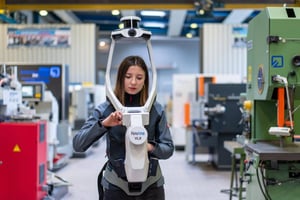When planning a project in a manufacturing facility, it’s vital to start with accurate information. While object-based CAD (Computer-Aided Design) renditions may be the most accurate version of the facility, in many cases they might not be available, might not reflect changes made since they were produced, or might be difficult to access based on organizational or license structures.
In addition, CAD software requires expensive licences and highly trained, specialist operators. To obtain an accurate picture of the facility as it is at the start of a project, it is simpler and cheaper to use laser scanning equipment, such as that produced by NavVis. Moreover, the point-cloud data obtained from laser scanning can be combined with other forms of plant information in a technique known as hybrid planning, which uses the most appropriate types of data for each part of the facility to make project planning more efficient.
The limitations of CAD in manufacturing
“The main issue with CAD is that it’s very expensive,” explains Nate McCall, a senior solutions consultant with NavVis who has experience as a factory planner with German automotive companies.
“It’s expensive because of the software platforms involved, the licensing cost of using them, and the workforce involved. When I was a planner, I didn’t have access to those platforms, and if I asked people who did work with CAD, they would often have access to a subset of the data. They might only have the files for a robot’s gripper, for example.”
Different teams within the organisation would have access to the data relevant to their function, such as plant logistics or operator safety. McCall also points out that different departments might use different CAD software, making the process even more difficult.
“It raises the propensity for planning mistakes, inefficiency, waste, ill-informed decisions, and other things that can all lead to increased cost,” he said.
Planning made easy with laser scanning
By contrast, laser scanning the facility – building up a cloud of points of laser light reflected from the real buildings and equipment – provides a digital version of what exists, independent from CAD drawings that might in any case be inaccurate, incomplete, or unavailable.
“With our solution, you have a comprehensive representation of the shop floor,” McCall says.
“Regardless of who owns the data, regardless of whether it’s equipment associated with logistics or manufacturing, it’s going to be in the scene because we’ve captured it with our device. Everything’s cloud based, you don’t need a special CAD laptop to view it, and it’s a simple, intuitive user interface. “
The cost savings are significant, he added, because unlike with the processes needed to generate detailed CAD drawings – measurements, drawings, and dedicated computer hardware to run CAD software, the process to map the shopfloor is simple. “I just need to walk around with a laser scanner and capture the data.”
Combining CAD and reality capture data in hybrid planning
Once the data have been captured, they can be used in hybrid planning. This combines several different types of data, such as point clouds, meshes – a way of grouping together points that are close together in space, such as all the points reflected from a surface – and CAD data, where it is available, to produce an accurate rendition of the shopfloor.
McCall explains that the key is using the most appropriate kind of data for each part of the facility. “If I’m trying to simulate an area of a facility, I probably don’t need CAD data for the building,” he says. “Maybe I can use point cloud data for the building. Maybe I can use mesh data for the safety fencing around the robots.”
The most important part of a manufacturing facility – the part most likely to be the focus of project planning – is the robots themselves and what they are doing, he adds.
“As I get closer to where the value-added process is, that’s where I really need to create insights. The closer I get to that value add spot, that’s where I really might need object-based CAD data so I can simulate kinematics.”
If you'd like to talk to a NavVis expert about any of the features or ideas shared in this blog, contact us here.

